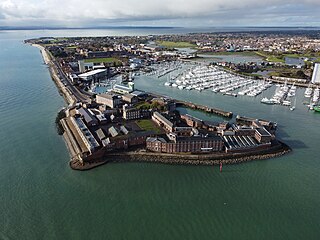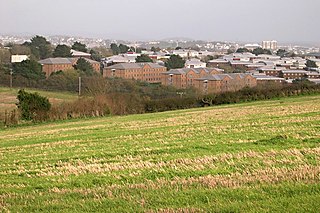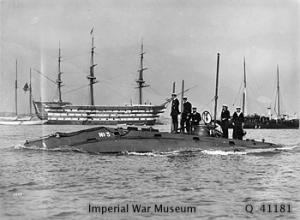
Gosport is a town and non-metropolitan borough, on the south coast of Hampshire, South East England. At the 2021 Census, its population was 81,952. Gosport is situated on a peninsula on the western side of Portsmouth Harbour, opposite the city of Portsmouth, to which it is linked by the Gosport Ferry. Gosport lies south-east of Fareham, to which it is linked by a Bus Rapid Transit route and the A32. Until the last quarter of the 20th century, Gosport was a major naval town associated with the defence and supply infrastructure of His Majesty's Naval Base (HMNB) Portsmouth. As such over the years extensive fortifications were created.

Admiral of the Fleet Michael Cecil Boyce, Baron Boyce, was a British Royal Navy officer who also sat as a crossbench member of the House of Lords until his death in November 2022.

Fort Blockhouse is a military establishment in Gosport, Hampshire, England, and the final version of a complicated site. At its greatest extent in the 19th century, the structure was part of a set of fortifications which encircled much of Gosport. It is surrounded on three sides by water and provides the best view of the entrance to Portsmouth Harbour. It is unique in two respects. Firstly, it was built over five centuries from its original construction as a blockhouse in 1431 to the final addition of submarine base structures in the mid-1960s. Secondly, it is thought to be the oldest fortified position in the United Kingdom that is still in active military use though coastal fortification was abolished nationally in 1956, and it has been used only for medical purposes since 2020.

Commander Donald Cameron, VC was a Scottish sailor and a recipient of the Victoria Cross, the highest award for gallantry in the face of the enemy that can be awarded to British and Commonwealth forces. He is one of three VC recipients from the small town of Carluke in South Lanarkshire. The Rotary Club of Carluke have erected a millennium stone in the town market place to commemorate this.
Numerous Royal Navy vessels have been named HMS Dolphin after the dolphin.

The Royal Navy Submarine Museum at Gosport is a maritime museum tracing the international history of submarine development from the age of Alexander the Great to the present day, and particularly the history of the Royal Navy Submarine Service from the navy's first submarine, Holland 1, to the nuclear-powered Vanguard-class submarines. The museum is located close to the former shore establishment HMS Dolphin, the home of the Royal Navy Submarine Service from 1904 until 1999.

The Welman submarine was a Second World War one-man British midget submarine developed by the Special Operations Executive. It only saw action once and was not particularly successful.

HMS Alliance(P417/S67) is a Royal Navy A-class, Amphion-class or Acheron-class submarine, laid down towards the end of the Second World War and completed in 1947. The submarine is the only surviving example of the class, having been a memorial and museum ship since 1981.

HMS Otus was a Royal Navy Oberon-class submarine launched in 1962. She was decommissioned in the early 1990s and is now a naval museum in Germany.

The Royal Navy Submarine Service is one of the five fighting arms of the Royal Navy. It is sometimes known as the Silent Service, as submarines are generally required to operate undetected.

HMS Raleigh is a stone frigate, serving as the basic training facility of the Royal Navy at Torpoint, Cornwall, United Kingdom. It is spread over several square miles, and has damage control simulators and fire-fighting training facilities, as well as a permanently moored training ship, the former HMS Brecon. Its principal function is the delivery of both New Entry Training and Basic Training.
The Submarine Escape Training Facility (SETF), also known as the Submarine Escape and Rescue Centre (SERC), is a facility used by submariners of the Royal Australian Navy (RAN) to train in the techniques needed to escape from a submarine in trouble.

Holland 5 was the last of the five Holland-class submarines ordered by the British Admiralty to evaluate the potential of the submarine with the Royal Navy. She was one of the first submarines to be accepted into Royal Navy service, and unique to her class, she carried one of the earliest periscopes. By the time she was launched, a number of A-class submarines had already been ordered to replace this class in navy service.

Haslar is on the south coast of England, at the southern tip of Alverstoke, on the Gosport peninsula, Hampshire. It takes its name from the Old English hæsel-ōra, meaning "hazel-landing place". It may have been named after a bank of hazel strewn on marshy grounds around Haslar Creek to make it passable and habitable in old times, or merely because hazel grew there.

A Submarine Escape Training Tower is a facility used for training submariners in methods of emergency escape from a disabled submarine underwater. It is a deep tank filled with water with at least one underwater entrance at depth simulating an airlock in a submarine. Since the 1930s, towers have been built for use by the Royal Navy, US Navy, Royal Australian Navy and in several other countries.
Captain John Evelyn Moore was a submariner in the Royal Navy, a Fellow of the Royal Geographical Society and after retirement from the Royal Navy the author for 15 years of the authoritative naval publication Jane's Fighting Ships.

The Royal Navy's Submarine Parachute Assistance Group (SPAG) is a team who provide a rescue support capability to submarine sinking incidents worldwide, available at short notice.

Commodore Submarine Service is a post in the Royal Navy which involves command of the Royal Navy Submarine Service. It evolved from the post of Inspecting Captain of Submarines in 1901 and would later evolve to become the post of Flag Officer Submarines in 1944.
The Institute of Naval Medicine is the main research centre and training facility of the Royal Navy Medical Service.















